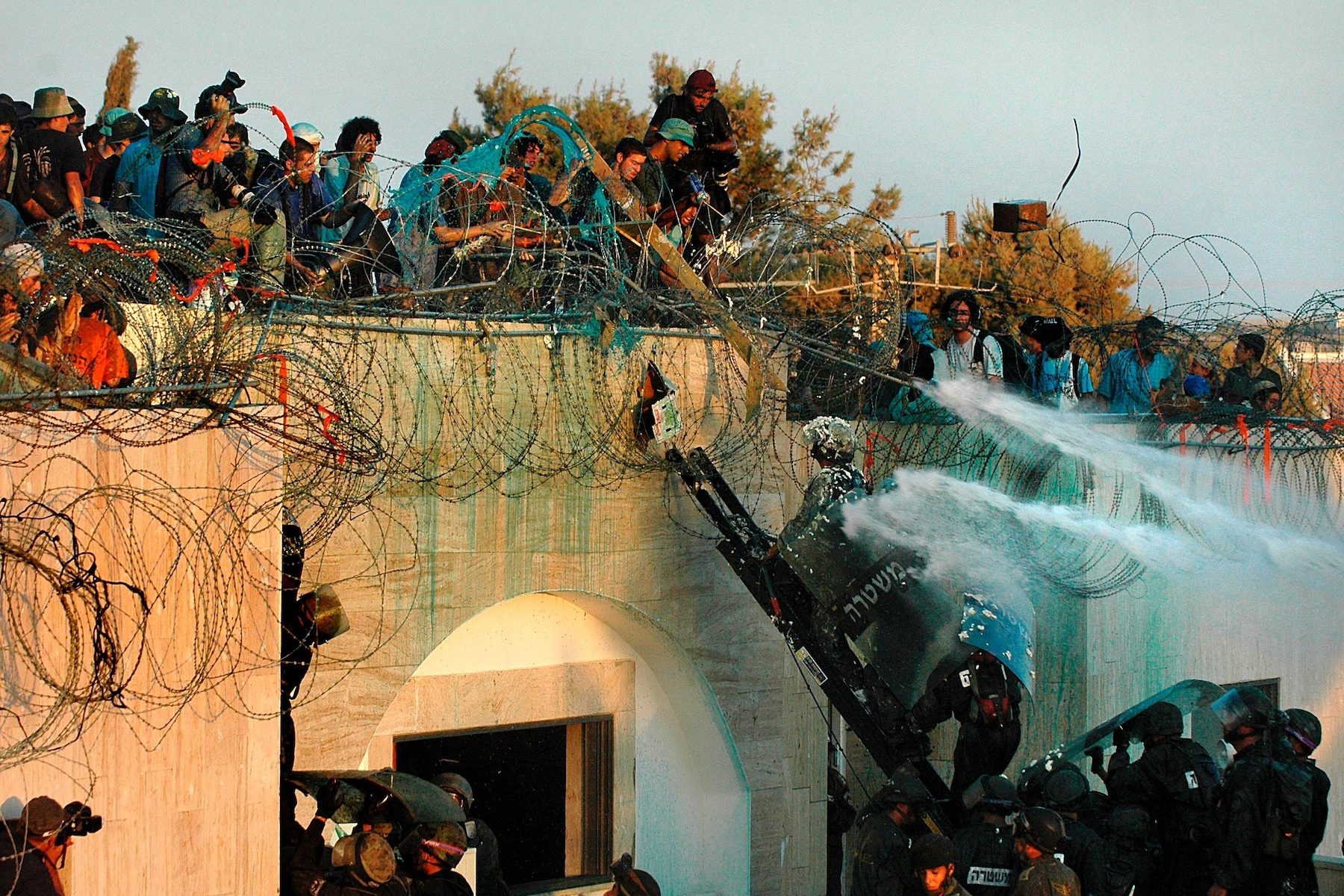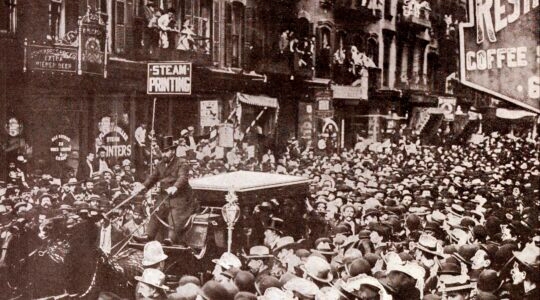
Israeli soldiers trying to evacuate Jewish settlers from the Gaza Strip in 2005. (Yossi Zamir/Flash90)
NEW YORK (JTA) — When I first heard about Ariel Sharon’s stroke — the first one, a minor brain attack about four weeks before he suffered the massive hemorrhage that would leave him comatose for the final eight years of his life — I was having dinner at a Jerusalem restaurant with a colleague from The Jerusalem Post. We both sat transfixed as we watched the TV over the bar.
It was December 2005, just five months after Sharon had completed Israel’s withdrawal from the Gaza Strip, and there was a sense that Sharon was in the midst of engineering a historic realignment of the Israeli-Palestinian conflict — one that might even end the messy marriage Israel had endured with the Palestinians since its conquests in the 1967 Six-Day War.
But then came news of the stroke, and suddenly it looked like folly to pin a nation’s hopes on an obese septuagenarian.
For years, Israel had suffered from the fickleness of Palestinian negotiating partners who had shown themselves either unwilling or unable to deliver on promises of security for Israelis. First came the bombings of the mid-1990s following the signing of the Oslo Accords in 1993. Then there were the devastating attacks of the second intifada on the heels of the failure of the Camp David summit between Ehud Barak and Yasser Arafat in 2000.
When Sharon was elected prime minister in a landslide in 2001, Israel’s responses to Palestinian attacks quickly grew harsher. One after another, militant Palestinian leaders were eliminated in targeted assassinations carried out by the Israeli military. In the West Bank, a barrier separating Jews from Palestinians took shape, keeping Palestinian suicide bombers at bay while inviting accusations against Israel of a land grab.
Though he had managed to silence Palestinian attacks with an iron fist, Sharon did not stop once the attacks had subsided. He believed that more bloody confrontations and international isolation lay ahead if Israel were to remain inextricably tied to the Palestinians, and he shocked many longtime supporters when he told Likud party lawmakers in 2003 that Israel could not “keep 3.5 million Palestinians under occupation” indefinitely.
Thus began his effort to unilaterally “disengage” Israel from the Palestinians, starting with the 9,000 Jewish settlers and soldiers in the Gaza Strip. Despite the heart-wrenching scenes of Jews being dragged from their homes and Palestinians celebrating atop the ruins of abandoned Israeli settlements, Sharon managed to complete the withdrawal as planned in the summer of 2005, and the country held its breath to see what would come next.
Compared to the West Bank, Gaza was easy. There were relatively few Jewish settlers in Gaza amid the more than 1.5 million Palestinians, the strip offered Israel no tactical military advantages and the Jewish people did not have deep historical ties to Gaza.
By contrast, the West Bank held more than 250,000 settlers, represented a strategically valuable buffer between Israel and its Arab adversaries to the east, and was a repository of Jewish history dating back to the Bible.
Everyone knew disentangling Israel from West Bank Palestinians would be hard, but if anybody could do it, it was Sharon, an architect of the settlement movement and the man who once declared that the face of Netzarim, a Jewish settlement in Gaza, was the fate of Tel Aviv.
When Gaza’s Jewish settlements were leveled amid the 2005 pullout, the nickname Sharon had acquired during his military days, Bulldozer, took on a new connotation, and many of his settler supporters turned against him. As a sign of his new direction, Sharon broke from the rightist Likud faction and founded a new centrist political party, Kadima, which peeled off moderates from the left and right and instantly became Israel’s largest political grouping.
Then came the second stroke on Jan. 4, 2006, and Sharon was gone.
It was obvious from the get-go that Israel’s accidental new leader, Ehud Olmert, could not fill Sharon’s shoes.
Sharon was a warrior-statesman whose legendary battlefield feats dating back to Israel’s 1948 War of Independence had earned him the respect of adversaries and supporters alike but who seemed more at home with the sheep on his Negev ranch than with politicians in Jerusalem. Olmert was a wheeler-dealer ex-mayor with scant military experience, an affinity for expensive cigars and a habit of never turning down an opportunity to travel to New York.
He quickly got into trouble. The Palestinians in Gaza tested Olmert with incessant and growing rocket fire. In 2006, when the Lebanese militant group Hezbollah attacked an Israeli military patrol and abducted two soldiers, Olmert launched a 34-day war that went on long enough to demonstrate that Israel could not quite vanquish Hezbollah.
Any notion of extending Sharon’s disengagement plan to the West Bank quickly faded, Olmert resigned under a cloud of corruption, Benjamin Netanyahu was elected prime minister and the Israeli-Palestinian conflict fell into deadlock. Today, the conflict seems as intractable as ever.
In the years since he was felled, Sharon’s critics have pointed to the rocket attacks from Gaza and the missile threat from Lebanon as evidence that any unilateral withdrawal from the West Bank would have been a disaster for Israel, bringing its heavily populated center, including Jerusalem and Tel Aviv, within range of enemy rockets.
Would Sharon have come to believe that his withdrawal from Gaza was a mistake? I doubt it. He believed that diverting copious military resources to keep a few thousand Jews amid a sea of Palestinians in a strip of land Israel never wanted in the first place was not sustainable militarily or diplomatically.
Would Sharon have replicated his model of withdrawal in the West Bank? He believed that time was not on Israel’s side, that the occupation was bad for Israel’s diplomatic standing, cost too much in terms of money and lives, and was a demoralizing drain on the Israel Defense Forces and the Jewish people.
By all indications, Sharon’s plan for the West Bank was to redraw Israel’s borders unilaterally to keep as many Jewish settlers as possible, as few Palestinians as possible and as much open territory as possible — including the strategically valuable Jordan Valley. If he could have pulled it off, it would have angered Israeli nationalists and Palestinians, and Sharon would have faced a deeply skeptical international community.
But it also probably would have resulted in a state for the Palestinians — something Sharon endorsed in 2001 — and given Israel a shot at ending the messy entanglement of the Israeli and Palestinian populations.
This vision may not be so far off from what Netanyahu says he wants, but we haven’t seen much progress toward the goal.
The first time I got to talk to Sharon was during a visit he made to New York as foreign minister in 1999. I was among the scrum of reporters squeezed into Mayor Rudy Giuliani’s office in City Hall during a news conference, and I asked Sharon if he had any intentions of being prime minister.
Sharon responded dismissively, as if the notion of having political ambitions were beneath him. Months later he’d become Likud’s leader, and a year-and-a-half after that prime minister.
Sharon quickly made clear that he was in office to take action. The wisdom of his moves could be debated — and were — but not their boldness.
Eight years after his premature exit, and in the wake of his death on Saturday at the age of 85, Israel remains stuck in a holding pattern waiting for some bold move that will lift the nation out of its morass with the Palestinians.
JTA has documented Jewish history in real-time for over a century. Keep our journalism strong by joining us in supporting independent, award-winning reporting.







